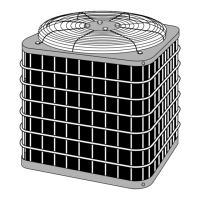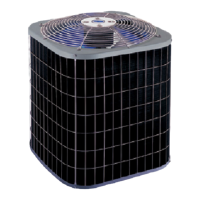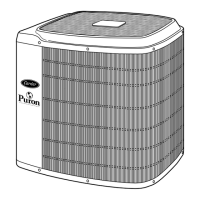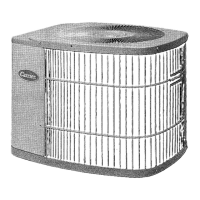Do not vent refrigerant to atmosphere. Recover during system
repair or final unit disposal.
Follow these steps to properly pumpdown a system and avoid
negative suction pressure.
1. Fully back seat (open) liquid and vapor tube service valves.
2. Unit is shipped with valve stem(s) front seated (closed) and
caps installed. Replace stem caps after system is opened to
refrigerant flow. Replace caps finger-tight and tighten with
wrench an additional 1/12 turn. Use a backup wrench on valve
body flats to prevent distortion of sheet metal.
3. Close electrical disconnects to energize system.
4. Set room thermostat to desired temperature. Be sure set point
is below indoor ambient temperature.
5. Set room thermostat to HEAT or COOL and fan control to ON
or AUTO mode, as desired. Operate unit for 15 minutes.
Check system refrigerant charge.
SEQUENCE OF OPERATION
NOTE: Defrost control board may be equipped with 5-minute
lockout timer which may be initiated upon any interruption of
power.
With power supplied to indoor and outdoor units, transformer is
energized.
Cooling
On a call for cooling, thermostat makes circuits R-O, R-Y, and
R-G. Circuit R-O energizes reversing valve, switching it to cooling
position. Circuit R-Y energizes contactor, starting outdoor fan
motor and compressor circuit. R-G energizes indoor unit blower
relay, starting indoor blower motor on high speed.
When thermostat is satisfied, its contacts open, de-energizing the
contactor and blower relay. Compressor and motors should stop.
NOTE: If indoor unit is equipped with a time-delay relay circuit,
the blower runs an additional 90 sec to increase system efficiency.
Heating
On a call for heating, thermostat makes circuits R-Y and R-G.
Circuit R-Y energizes contactor, starting outdoor fan motor and
compressor. Circuit R-G energizes indoor blower relay, starting
blower motor on high speed.
Should temperature continue to fall, R-W2 is made through
second-stage room thermostat bulb. Circuit R-W2 energizes a
sequencer, bringing on first bank of supplemental electric heat and
providing electrical potential to second heater sequencer (if used).
If outdoor temperature falls below setting of outdoor thermostat
(field-installed option), contacts close to complete circuit and bring
on second bank of supplemental electric heat.
When thermostat is satisfied, its contacts open, de-energizing
contactor and sequencer. All heaters and motors should stop.
Defrost
The defrost control is a time/temperature control which includes a
field-selectable (quick-connects located at board edge) time period
between defrost cycles (30, 50, or 90 minutes), factory set at 90
minutes.
The electronic timer and defrost cycle start only when contactor is
energized and defrost thermostat is closed.
Defrost mode is identical to cooling mode except that outdoor fan
motor stops and second-stage heat is turned on to continue
warming conditioned space.
To initiate defrost, the defrost thermostat must be closed. This can
be accomplished as follows:
1. Turn off power to outdoor unit.
2. Disconnect outdoor fan motor lead from OF2 on control
board. (See Fig. 15.) Tape lead to prevent grounding.
3. Restart unit in heating mode, allowing frost to accumulate on
outdoor coil.
4. After a few minutes in heating mode, liquid line temperature
should drop below closing point of defrost thermostat (ap-
proximately 30˚F).
5. Short between speed-up terminals with a flat bladed screw-
driver. (See Fig. 15.) This reduces the timing sequence to
1/256th of original time. (See Table 3.)
6. When you hear reversing valve change position, remove
screwdriver immediately; otherwise, control will terminate
normal 10-minute defrost cycle in approximately 2 sec.
NOTE: Length of defrost cycle is dependent on the length of time
it takes to remove screwdriver from test pins after reversing valve
has shifted.
7. Unit will remain in defrost for remainder of defrost cycle time
or until defrost thermostat reopens at approximately 80˚F coil
temperature of liquid line.
8. Turn off power to outdoor unit and reconnect fan motor lead
to OF2 on control board. (See Fig. 15.)
Step 15—Check Charge
Factory charge is shown on unit rating plate. To check charge in
cooling mode, refer to Cooling Only Procedure. To check charge
in heating mode, refer to Heating Check Chart Procedure.
Table 3—Defrost Control Speed-Up
Timing Sequence
PARAMETER
MINIMUM
(MINUTES)
MAXIMUM
(MINUTES)
SPEED-UP
(NOMINAL)
30-minute cycle 27 33 7 sec
50-minute cycle 45 55 12 sec
90-minute cycle 81 99 21 sec
10-minute cycle 9 11 2 sec
5 minutes 4.5 5.5 1 sec
Fig. 15—Defrost Control
A91444
OF1
OF2
O
R
T2 Y
TI
DFT
C
TEST
30
50 90
W1
O
R
W2
Y
C
CES0110063,
CES0130024
11
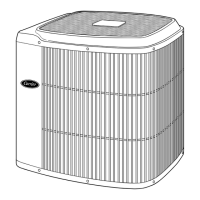
